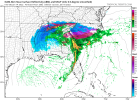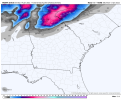Yeah, it showed a N shift and more rain, it’s obviously having issuesAnybody else have trouble with the site a few minutes ago?
-
Hello, please take a minute to check out our awesome content, contributed by the wonderful members of our community. We hope you'll add your own thoughts and opinions by making a free account!
You are using an out of date browser. It may not display this or other websites correctly.
You should upgrade or use an alternative browser.
You should upgrade or use an alternative browser.
Misc 2021-22 Fall/Winter Whamby Thread
- Thread starter jackendrickwx
- Start date
Also, we really need a vomiting emoji quick reaction.
Snowflowxxl
Member
Yep, wraparound is almost always overmodeledPeople getting excited about the reacharound!?
It was many moons ago, I think January of ‘02, I was in Greer , SC. Had a little winter storm go by and TWC said the reacharound was gonna give me 4-8” the next day. I woke up to milky sunshine and flurries. Remember this
NBAcentel
Member
Well hate to say it… @Myfrotho704_ you gotta go. Lol. J/k.Servers you okay View attachment 105260
bingcrosbyb
Member
Brent
Member
Decided not to go to mountains. Wife said she doesn't want to get stuck up there and possibly lose power. None of that bothers me, but listening to her ----- about it non stop would probably be the cause of our divorce.
And this is why I'm not married ???
LickWx
Member
Will you marry me? Uhhh … it’s only for tax purposes though. Man the federal gov taxes hell out of us singlesAnd this is why I'm not married ???
Spann be like nah it ain’t gonna snow. But we might have a tornadoes today. ??BMX looking to the west on Sunday morning after following GFS and not putting out watches/warnings
View attachment 105261
View attachment 105257
Unreadable
Storm5
Member
Got some tight buttholes tonight . That's all ....
Sent from my iPhone using Tapatalk
Sent from my iPhone using Tapatalk
I was pushing a webserver config change to help, probably when I restarted the service it threw that error.
I fully expect full meltdown in about 45 minutes.
I fully expect full meltdown in about 45 minutes.
bigstick10
Member
Interesting....Got some tight buttholes tonight . That's all ....
Sent from my iPhone using Tapatalk
Snowed In
Member
Tonight's model runs will contain both..... “The thrill of victory and the agony of defeat”
LickWx
Member
BufordWX
Member
Current Score: 35 mentions 
“Been pretty consistent on that front end thump”
Sent from my iPhone using Tapatalk

“Been pretty consistent on that front end thump”
Sent from my iPhone using Tapatalk
Brent
Member
Got some tight buttholes tonight . That's all ....
Sent from my iPhone using Tapatalk
Kinky
Got some tight buttholes tonight . That's all ....
Sent from my iPhone using Tapatalk
Alabama and Atlanta folk are like: grasping straws right now.
Sent from my iPhone using Tapatalk
LovingGulfLows
Member
- Joined
- Jan 5, 2017
- Messages
- 1,382
- Reaction score
- 3,643
Time to hug the RGEM even tighter 0z run has us closing in on double digits. LolView attachment 105274
I hate seeing that tight gradient....10 miles to the north is getting 5-7 inches while I'm getting 2-3 inches.
Not buying the Nam going back and forth between sleet and snow. We get snow for a good half hour and we’re done. That’s just how it goes around CLT
GeorgiaGirl
Member
Yeah, I don't know about that one, unless the GFS is on the money temp wise, which I have my doubts.
Should note that I don't expect anything, but I shouldn't have waved my dad off, as it's been pretty close. But I'd rather miss, because I'm not a fan of ice.
I love the ICON.
NBAcentel
Member
Maybe a hour - 2 hours this time, but hey the couple inches of sleet is gonna look like snow anywaysNot buying the Nam going back and forth between sleet and snow. We get snow for a good half hour and we’re done. That’s just how it goes around CLT
gfs gonna be warm again i guess. i give up on it.
Where’s accu35? He’s in the game
Went out straw grasping according to other poster in here.. ??Where’s accu35? He’s in the game
Webb gives me 8” in the mountains with sleet. I’m cancelling
Nah no where close. In it to win it!! ?Alabama and Atlanta folk are like: grasping straws right now.
Sent from my iPhone using Tapatalk
Stephenb888
Member
Each model run gets warmer and warmer. I might be able to cut grass by Sunday.
Inb4 Wake Co WWA for glazeNick Petro at RAH says that watches will likely be issued tonight/tomorrow morning, then a warning on Saturday.
GFS warmer, North, and gulf storms robbing moisture transport! Triple whammy
Each model run gets warmer and warmer. I might be able to cut grass by Sunday.
You and dadofjax are related
if the gfs is right here, temp wise etc. i will not even bother looking at another model again in the future. it has legit stuck to its guns, even against its own ensemble.
They are sons of MrGolfYou and dadofjax are related









